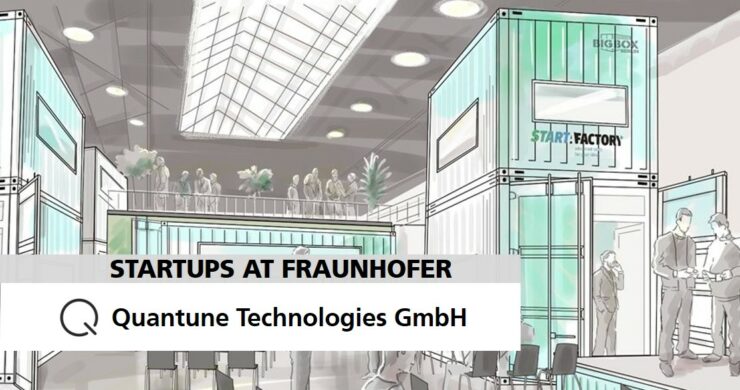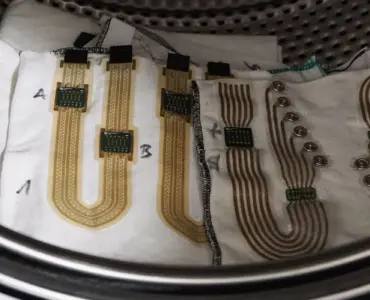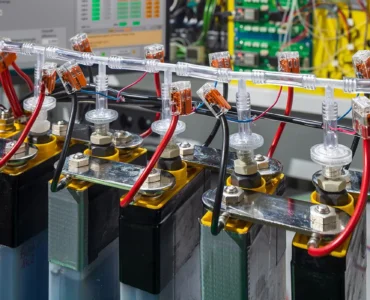Non-invasive blood glucose monitoring systems are one of the hottest topics in current medical technology. That is one of the reasons why the FMD space, which Fraunhofer IZM is a part of, endowed the idea of the start-up Quantune Technologies with a prize last winter.
In an interview with RealIZM, the team of Quantun Technologies speaks about their revolutionary use of a photonic sensor for diabetic patients, its advantages, other potential applications, and the challenges still lying ahead on the way to miniaturized biomedical sensors.
Tell our readers about your company and the technology you are developing.
Quantune Technologies: We are Quantune Technologies, and we started operating as a company in October 2019. We are building a microscopic “handheld” light source that we’re planning to install in a device to measure blood sugar with light and nothing else. There are a number of other companies that are also researching non-invasive blood glucose monitoring, but they are all facing the same problem of developing a convenient light source. The method, using what we call a mid-infrared light source, has already been proven possible in the laboratory, but the devices they are using are quite large and cost around 30.000 euros. We are working towards making similar devices with a new type of miniature laser for only 300 to 500 euros. You can imagine the device looking like a smartphone, with a fingerprint sensor that you simply swipe to get an immediate blood sugar reading.
For our project, we developed a technological concept and got support from the Research Fab Microelectronics Germany (FMD), one of the strongest technology research partners in Germany.
So your new device is much smaller, cheaper, and non-invasive – no pricks and needles anymore. Are there any other advantages?
Quantune Technologies: Another important advantage is that it needs no consumables. You buy it once, use it many times. Compared to the current method with needles, this is a big step forward. First, of course, because it saves a lot of waste, but also because it means a financial advantage in the long run. There is the upfront investment, but no on-going costs.
In addition, the technology would enable widespread early detection of diabetes, especially for higher risk groups, such as babies, pregnant women, or the elderly. That is vital, because early detection goes a long way towards avoiding severe complications for the sufferers of the most common form, type-2 diabetes, in particular. All of the tests we have right now depend on pricking your finger, which is why many people don’t want to be tested if they don’t show any signs of the disease. Fewer tests means fewer early detections. But with our new measuring devices, routine checks would be quick and painless and available for everybody.
Can the device only measure blood sugar levels, or are there other possible use cases?
Quantune Technologies: Actually, there are indeed other options. When you take a measurement through the skin, you could, for example, measure lactate concentration, which is an important indicator for professional athletes. It is also possible to install the laser in a dialysis machine to constantly monitor the various blood parameters of the patient, without having to constantly take new blood samples. But we could also conceive of applications outside of the health sector. Our laser could also be used to detect chemical changes in goods, for example in oil refineries or in the food industry. What I mean is that the device can read the chemical composition and send an alarm in the event of a critical change, for instance when it spots toxins.
And how exactly does this technology work?
Quantune Technologies: For spectroscopic analysis, you basically have to be able to adjust the wavelength of the light, i.e. the red, blue, and green components must be emitted separately. Of course, we’re working in the invisible infrared range, but the color analogy works just as well for these wavelengths. Our technology uses a laser chip that is only about a hundredth the size of a human hair in thickness. The light emitted by the laser chip is thrown onto a wavelength selector, which filters out and transmits the set wavelength. To give you a sense for the scale of it and how it works, picture a conventional laser device: You aim a laser pointer at a person across the length of a football pitch. The person you are pointing at is supposed to use a mirror to precisely reflect the laser beam back onto a penny you are holding in your other hand. When any part in this moves or shakes even minutely, the beam will miss the penny and the measurement is impossible. Of course, slight movement or vibrations happen all the time in a portable device. For this reason, the mirror and laser need very sturdy fittings and very fine adjustment during the manufacturing process, which costs a lot of time and money.
To solve this problem, we came up with a physical trick. We took the problem of wavelength selection and separated it into two parts. In the first part, we first stabilize the beam with a so-called “cat’s eye”, not unlike the reflectors that we all know from bicycles or traffic signs. They throw the light back exactly in the direction it came from. In the second part, the wavelength is selected by using a transmissive filter, which you could imagine like a stained glass church window, which only allows a certain wavelength to pass. These two components together then cause the light of a certain wavelength to always radiate back exactly where it came from – no matter how you move the device. This eliminates the need for fine adjustment during the manufacturing process, and manufacturing becomes more scalable and suitable for mass production. As a result, we can use semiconductor manufacturing processes and manufacture large quantities automatically, similar to how computer chips are produced.
Are there any findings that indicate whether the light rays have an impact on the patient’s health?
Quantune Technologies: The radiation is absolutely harmless to humans and is comparable to having a flashlight pointed at you. There is only minimal warming at a level of only a thousandth of a degree centigrade, which you could not feel and which could not harm you.
Have you already received patents for the technology, and how tough is it to get it approved?
Quantune Technologies: Yes, we actually already have a number of patents for this technology. We are now well connected, and we fortunately have a very good medical technology network. We are in contact with other founders who have already launched many products in this area. They, in turn, are in touch with other specialists who have a lot of experience in the approval process for medical technology standards. Finally, however, we are not commercially dependent on the health sector alone, because we can also use our special light source in a variety of industrial applications, where the approval process is less strict and complicated.
Where would you see yourself in terms of your development journey?
Quantune Technologies: We have already developed a prototype that is about the size of a grapefruit. As our next step, we want to up the miniaturization as part of the FMD-Space project and build a demonstrator that is only as big as a cube of sugar. Our goal is to keep the measurement quality consistently high and to reduce the size and costs as much as possible. This project phase has just started and will take 12 months. We are planning for a fully functional prototype in a year. As an analogy with our invention, think of shrinking a turntable down to an MP3 player. It is like we have reimagined an existing technology from scratch and made the transition from the mechanical to the digital.
What major challenges are you expecting ahead of you?
Quantune Technologies: At the technological level, we have just overcome one of the greatest challenges by being accepted by the FMD, which enables us to build our microsystem by supplying us with all the necessary components. We have now managed to gain the trust of the technological specialists, and we are very grateful for that! Apart from that, the biggest hurdles are in the organizational area. If there are any delays in funding, for example, this would cause us real problems.
Where do you see yourself and your company in five years from now?
Quantune Technologies: Our vision is to make blood sugar measurements easily accessible for everybody in order to give every person affected a significantly better quality of life. We want to have this problem solved in five years’ time. And beyond that, we want to make this technology accessible for everyone so that we can all lead healthier lives.





Add comment